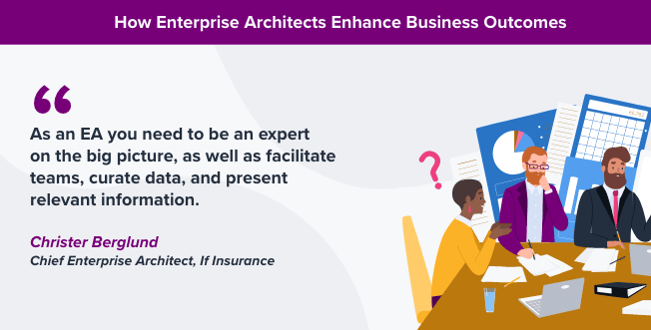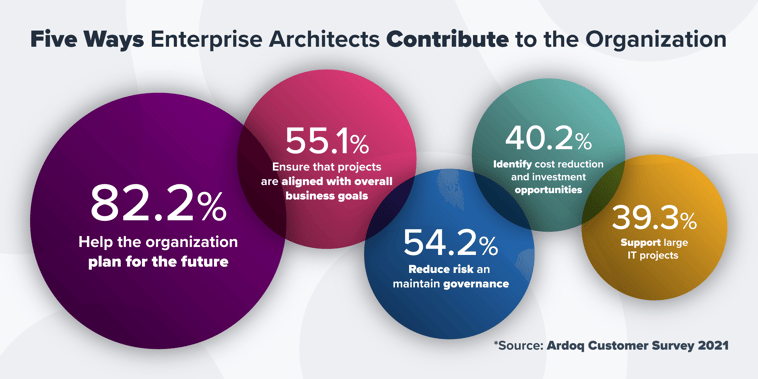Just as you can’t steer a ship without a captain, a strategic change initiative without an architect is bound to stray from its course. With enterprise architecture still largely misunderstood, the role of an enterprise architect (EA) can feel ambiguous. Their place within the larger organization is somewhat unclear to managers reviewing their purpose. Even EAs themselves sometimes struggle to articulate the value of the work they deliver, which can sabotage their efforts to secure executives’ buy-in on proposed projects.
Enterprise architecture bridges the business side of an organization with its IT in order to optimize both. This transformation doesn’t happen magically though; it needs an EA to bring it to fruition. An EA accomplishes this by connecting the dots between the different parts of the organization so that everyone can collaborate with the same understanding of the company, how it operates with IT, and what they can anticipate as the impacts of any change to that infrastructure. Together, they can determine the best solutions to both pressing problems and initiatives designed to take the organization into the future.
Without being able to advocate for themselves though, EAs will find themselves relegated to more passive roles, instead of being true strategic agents for change. EAs therefore have a lot of potential to shape their organizations, so it’s up to them to understand the full scope of their role to deliver on their promise. Here are five ways EAs enhance business outcomes and are true strategic agents, according to more than 100 Ardoq customers:
1. Enterprise Architects Help the Organization Plan for the Future
To help EAs understand their potential, we asked over 100 Ardoq customers—real EAs at work moving their businesses forward—about their biggest contributions to their companies. They overwhelmingly cited their ability to help their organizations plan for the future (82%). EAs can function as a strategic arm of their organization’s executive teams on the overarching vision, collaborating with business leaders and stakeholders. By using their unique understanding of the business and its IT ecosystem, they’re well-positioned to identify change projects that will drive the business towards those goals.
Strategic architects take big ideas and translate them into tactical, tangible plans. With the right technology, they can model scenarios to forecast the outcomes of their suggestions before they take effect and calculate how to reach them (including any trade offs that will need to be made in the process). This roadmap saves the company time and costs, instead of wasting resources on rounds of trial and error.
2. Enterprise Architects Identify Cost Reduction and Investment Opportunities
As EAs figure out ways to improve their organization’s performance, a strong starting point is identifying cost reduction and investment opportunities. They can’t make strategic plans a reality if they’re working with an unsteady IT foundation, so EAs will want the tech stack running as efficiently as possible. Likewise, they’ll want to ensure workflows are running as efficiently as possible.
Static records of the business and IT architecture won’t serve EAs in this effort. Instead, agile EAs will arm themselves with dynamic application portfolio management (APM) tools, which will allow them to capture a holistic view of their enterprise’s tech stack so that it can view investments side by side. That way, they are more likely to recognize which technologies are undercutting the organization’s performance, overlapping in capabilities, or simply wasting time and money.
👉 Get the Ultimate Guide to Application Portfolio Management
Beyond tech, EAs can also pinpoint underutilized employees, and think critically about how to better harness or support those individuals’ strengths to reach overarching goals.
By strengthening their organizations’ tech architecture--from the tech tools to the individuals leveraging them--EAs set up all efforts that rely on those technologies for success, while saving teammates time and energy they can devote towards achieving larger goals.
3. Enterprise Architects Ensure That Projects Are Aligned With Overarching Business Goals
Oftentimes, EAs play the role of custodians. They may be sidetracked by IT maintenance and justification, but there’s an opportunity for them to take their skills to the next level. As the bridge between business and IT, EAs can map projects to overarching business goals to move the organization from its “as-is” state to an ideal one, instead of just keeping up. Instead of following the typical route of proposing new projects for the sake of transformation, they can make sure all initiatives serve an explicit, measurable purpose.
To achieve this synergy, EAs need to proactively connect with business leaders to understand their expectations and priorities, so that they can devise strategies accordingly. Consider what the organization is trying to achieve. Is the primary goal to:
- Achieve strategic transformation?
- Manage mergers and acquisitions?
- Improve security and compliance?
- Cut costs?
Adjustments to the company’s infrastructure--from investments to the assignments employees are working on--should support whatever mission business leaders are hoping to achieve at scale. Otherwise, they’ll pour resources into projects that yield few (or irrelevant) returns. Plus, by asking business leaders to articulate their expectations, EAs can collaborate with them to zero in on the best path towards achieving them.
4. Enterprise Architects Reduce Risk and Maintain Governance
Whereas typical IT teams can be siloed from the rest of the organization, EA’s positioning between business and IT offers them critical and encompassing insights that enable them to manage the impact of change and avoid any unintended consequences. EAs are able to look at how variables other than technology are influencing organizational performance and react accordingly
When assessing the organization’s business and IT architectures for opportunities, EAs should also be on the lookout for any areas that present risks. Engaging colleagues across the organization is key to this effort. That’s because, from people and projects to the tools organizations invest in to support them, businesses are full of complex relationships and dependencies—some of which aren’t always obvious to everyone within an organization. For example, if a member of the leadership team proposes cutting or adding IT investments without realizing how they influence others’ workloads, they risk creating bigger problems than the ones they were first trying to solve.
With so much on their plate, holding conversations with each of their colleagues to understand their exact positioning within the business isn’t the most feasible course of action. That’s where a modern enterprise architecture platform can help. With democratic access and distributed governance management, employees across departments can provide input on their respective areas of the business to maintain control in a way that makes the most sense to that specific subject, instead of the EA guessing at how to manage.
👉Unlock the Full Value of Enterprise Architecture with Effective Governance and Engagement
5. Enterprise Architects Can Support Large IT Projects
Business performance and IT architecture are deeply linked. Without the right tools, employees can’t reach their full potential in their roles. That being said, executing large IT projects requires more than just the initial decision to invest; they require continued progress checks to ensure implementation is seamless. EAs can manage the implementation process by leveraging their unique view of the organization to direct each step. Here’s where their data models come in handy. Because EAs have taken the time to map the path from the organization’s current state to its future one, EAs can more clearly see and assess progress, catching any shortcomings ahead of time before they create larger vulnerabilities.
👉Read more: Cloud Migration Checklist: 5 Elements to Connect Your Business Goals
As more and more businesses turn to enterprise architecture to direct their digital transformation efforts, EAs are poised to maximize those efforts—but they first need to understand how. By regularly engaging colleagues across their organizations hierarchies and tapping modern tooling to support their work, EAs can make business decisions that wow leadership and optimize business outcomes.
With any new program—no matter how well-intended or researched—there are bound to be road bumps. We’ve surveyed more than 100 Ardoq customers and identified 5 Mistakes to Avoid in Enterprise Architecture; learn what they are to avoid them, and correct them when they occur.
 Leah Plotz
With over ten years of experience working in content, Leah wants to make sure Ardoq empowers engagement and collaboration throughout an organization.
Leah Plotz
With over ten years of experience working in content, Leah wants to make sure Ardoq empowers engagement and collaboration throughout an organization.






/Logos/Ardoq/RGB_Ardoq_Logo_Stacked_White_Monochrome%201.png?width=80&height=77&name=RGB_Ardoq_Logo_Stacked_White_Monochrome%201.png)

